| Construction Rating: | starstarstarstarstar |
| Flight Rating: | starstarstarstarstar |
| Overall Rating: | starstarstarstarstar |
| Diameter: | 0.98 inches |
| Length: | 36.90 inches |
| Manufacturer: | FlisKits  |
| Skill Level: | 3 |
| Style: | Futuristic/Exotic |
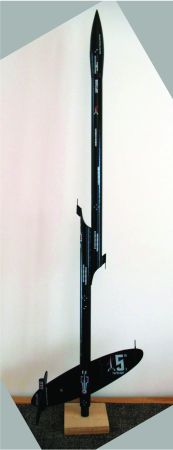
Brief:
This is truly a unique kit. It has a sleek, non-symmetric, futuristic look with an elaborate fin pattern and a split
body tube design that creates an ejection baffle. It is a Skill Level 3 with recommended engines, B6-4 and C6-5. There
are a lot of parts, including many fins that have to be cut from balsa stock and aligned. The fin design and
arrangement are truly unique--three different sizes of the same oval shape placed at non-symmetrical sites with
alternating slants. The pictures in the catalog and on the package do not give it justice. In fact, unless you have
actually seen a Night Whisper in person, you do not realize the full fin pattern until you are well into construction.
The decals are extensive, very imaginative, and give added detail and authenticity to the rocket. My wife purchased the
Night Whisper for me because she liked its sleek look (Thank you Mr. Flis!).
Construction:
The parts list:
- 18" BT-50 Body Tube - 2
- 2.75" BT-20 Body Tube - 1
- 3" BT5 Body Tube - 1
- 1/8 " Balsa Fin Stock
- 3/32" Balsa Fin Stock
- 1/32" Balsa Fin Stock
- Balsa Nose Cone - 1
- 18 mm engine mount with hook - 1
- Centering Rings - 2
- Fiber Slugs - 2
- 0.062" Basswood Square - 1
- 0.040" Basswood Square - 3
- 24" Shock Cord - 1
- FlisKits 16 " Parachute Kit - 1
- 36" Kevlar® Shock Line - 1
- Screw Eye - 1
- 1/8" x 2" Launch Lug - 2
- Decal Sheet - 1
- Fin Pattern Sheet - 1
- Instruction Booklet - 1
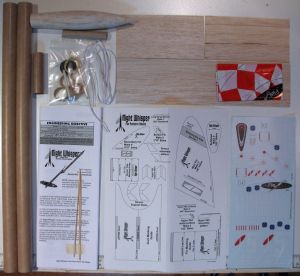
The warning upfront on the Night Whisper is that it has a lot fins and a number of small parts that need to be cut and sanded from 3 different balsa stocks and basswood sticks. This takes some time and even more patience. Cutting and sanding fins is not one of the things I enjoy about rocketry. So I really had to slog through this. But in the end, it was worth the effort.
As is usual for FlisKits, the instructions with accompanying illustrations are excellent. The construction starts with a standard 18mm engine mount that is inserted into one of the BT-50 body tubes. The BT-50 body tubes are then trimmed to give a curved end and a narrow rectangle is cut just below this on both tubes using the pattern guide provided. A plug for each body tube is made from a centering ring and a fiber slug. One plug is glued to the curved/top end of what will be the lower body tube (the body tube with the engine mount) and one to the straight/bottom end of what will be the upper body tube. I put a coat of wood glue on the inside portion of the plug for the lower body tube as added protection since this plug would catch the blast from the ejection charge. The plug for the upper body tube has the Kevlar® string tied to it, which is threaded through the upper body tube before gluing. I filleted both plugs. A cap for the curved portion of both body tubes is made from the 1/32" balsa stock. Using the fin patter provided, a small teardrop pattern is cut from the balsa and glued to the curved end of each body tube. The thin balsa is flexible and can bend to match the shape of the body tube. Once the glue is dry, it is sanded to smoothness. Using the flexibility of the 1/32" thick balsa to fit a curved end is a neat idea and works really well. The two tubes are then glued together aligning the rectangle slits such that they appose each other. This gives the Night Whisper its unique design and creates a de facto baffle, since the ejection charge has to take two 90 degree turns to reach the nose cone. After aligning the two tubes, I taped them together and allowed the glue to dry.
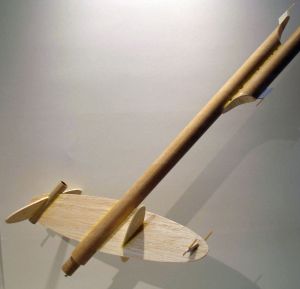 Now for the fins. I mentally prepared myself for this part of the construction,
poured myself a glass of wine and just got to it. I spread the fin cutting and sanding over two nights so as limit any
mistakes due to "fin fatigue". Once the fins were cut and sanded, the next step is to glue both of the two
main fins, labeled Fin #1 and Fin #2 on to the lower body tube using markings made earlier with a fin marking guide.
Fin #1 is actually split in two with a portion removed and replaced with the BT-5 body tube. Fin #2 is glued 180
degrees from Fin #1 and aligned such that the appearance is of a single fin separated by the lower body tube and
slanted upward left to right. The instructions call for Fin #2 to be glued 15/16" from the bottom of the lower
body tube to give this affect. However, to my eye, this didn't align properly. So I aligned Fin #2 by eye to give the
slanted affect, which resulted in placing Fin #2 1-1/8" from the bottom of the body tube. The secondary fins are
next glued to the primary fins. Two secondary fins are glued directly to Fin #2 to give a similar affect of a single
fin split by Fin #2 and slanted upward. To accomplish this, one secondary fin is glued to markings made with the Fin
marking guide. Once the glue is dry and the fin set, the second secondary fin is glued on the opposite side of Fin #2
to give the slanted affect. The placement is left to the builder. This is a little too free form for me. So I penciled
a line on this side of the fin to match the placement of the secondary fin on the opposite side. This would at least
give me the proper distance from the body tube. Alignment forward and aft was done by eye. The remaining two secondary
fins are glued to the BT-5 body tube of Fin #1 in such a way as to give the same slanted affect, but with a slant in
the opposite direction.
Now for the fins. I mentally prepared myself for this part of the construction,
poured myself a glass of wine and just got to it. I spread the fin cutting and sanding over two nights so as limit any
mistakes due to "fin fatigue". Once the fins were cut and sanded, the next step is to glue both of the two
main fins, labeled Fin #1 and Fin #2 on to the lower body tube using markings made earlier with a fin marking guide.
Fin #1 is actually split in two with a portion removed and replaced with the BT-5 body tube. Fin #2 is glued 180
degrees from Fin #1 and aligned such that the appearance is of a single fin separated by the lower body tube and
slanted upward left to right. The instructions call for Fin #2 to be glued 15/16" from the bottom of the lower
body tube to give this affect. However, to my eye, this didn't align properly. So I aligned Fin #2 by eye to give the
slanted affect, which resulted in placing Fin #2 1-1/8" from the bottom of the body tube. The secondary fins are
next glued to the primary fins. Two secondary fins are glued directly to Fin #2 to give a similar affect of a single
fin split by Fin #2 and slanted upward. To accomplish this, one secondary fin is glued to markings made with the Fin
marking guide. Once the glue is dry and the fin set, the second secondary fin is glued on the opposite side of Fin #2
to give the slanted affect. The placement is left to the builder. This is a little too free form for me. So I penciled
a line on this side of the fin to match the placement of the secondary fin on the opposite side. This would at least
give me the proper distance from the body tube. Alignment forward and aft was done by eye. The remaining two secondary
fins are glued to the BT-5 body tube of Fin #1 in such a way as to give the same slanted affect, but with a slant in
the opposite direction.
Next up are two small structures, the Long Range Sensors and Hyper-TAC Antennae. Any Trekkie will know what a Long Range Sensor is and I'm told by Jim Flis that the Hyper-TAC Antenna is: "Hyper for Hyper-space and TAC for Tachyon Acceleration Channel. Think of it as the United Solar Planetary Federation version of sub-space radio..." I never new balsa was so versatile! (And glad that something good would come out of cutting and sanding all those #@&$% balsa parts!). Both the Sensors and Antennae have support "skins" that are cut from the Fin Pattern Sheet and wrapped around and glued to each to give more strength. The Sensors are attached to Fin #2 yielding the same slanted affect as the primary and secondary fins. The Hyper TAC Antennae are small and delicate and the instructions say they are prone to breakage and can be moved to another location or not used at all. Flying through hyperspace without any communication is a little too risky for me so I installed them on my craft. Having said that, I inadvertently slanted one antenna in the wrong direction. I decided not to re-cut and sand another antenna (really?) but use it as is and point the antenna in the opposite direction on the upper body tube. The logic being that this would lead to better communication with one antenna pointing forward and one pointing aft!
The instructions next call for the installation of antenna and guns using the remaining basswood sticks. The instructions give an example but say that this step is up to the user and his/her imagination as to placement. The warning given is that, like the Hyper TAC Antenna, these are prone to breakage. I chose to leave these off.
The last part of construction was to install the launch lugs, screw eye, and shock cord and assemble the parachute. After that I filleted all fins, launch lugs, and attachment site for the upper and lower body tube.
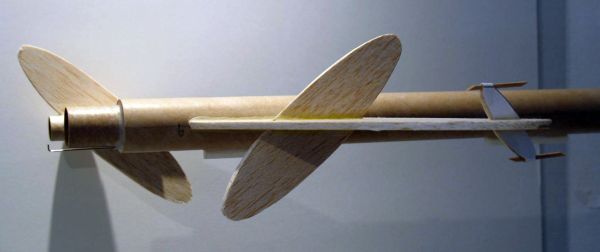
Finishing:
I gave all of the balsa parts six coats of sanding sealer, sanding in between each coat with 320 grit sandpaper. I
primed with 4 coats of Krylon white primer, sanding with 400 grit paper in between each coat and wet sanding after the
last coat. I then gave the Whisper four coats of Rustoleum Painter's Touch Gloss Black. The decals were next. There are
a lot of them and took some time and patience to place and I spaced this out over two days. There was one extra decal
(number 13, what appears to be two rows of square port holes). I placed it on the upper body tube, near the
intersection with the lower body tube. My only complaint about the decals (and it's a minor one) is that the individual
decals are arranged very close to each other on the sheet, making cutting the decals a little tricky. I let the decals
dry for 24 hours and then gave the Whisper three coats of Rustoleum Painter's Touch Crystal Clear Gloss.
Construction Rating: 5 out of 5
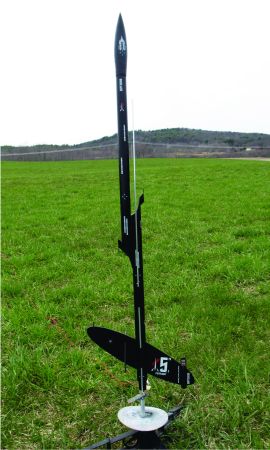
Flight and Recovery:
The maiden three flights were in mid-April on a cloudy New England day with winds at about 15 to 20 mph. Not the best
conditions, but we were eager to start the season. The first flight was with a B6-4. Just to be safe, I used one sheet
of wadding stuffed into the upper body tube. The Night Whisper struggled and wavered and made it to about 100ft with
ejection well past apogee. A B6-4, especially under these wind conditions, definitely does not have enough power for
the Night Whisper. Because of the strong winds, I used a 12" parachute. The rocket came down hard on the grass and
I lost the forward Hyper TAC Antenna. The second flight was with a C6-3, also with one sheet of wadding. This flew much
better. There was no struggle or waver and the rocket reached approximately 300ft with ejection right at apogee. It
also came down hard on the grass using a 12" parachute but with no damage this time. Finally, the third flight was
also with a C6-3. This time without any wadding. Again there was a nice straight flight to about 300ft, ejection at
apogee, and again a hard landing on the grass with no damage. There was also no burn damage to the parachute.
On a still day, a B6-4 and a longer delay C6 may work fine for the Night Whisper. But with significant winds I'd recommend sticking to a C6-3. I would also recommend a larger parachute, even under strong wind conditions. I was lucky to have only minor damage on my three flights with a 12" parachute. And no wadding is needed.
Flight Rating: 5 out of 5
Summary:
PROs: The sleek futuristic look, split body tube with a truly unique fin pattern and decals are all definite PROs. No
other kit looks like this. The built-in baffle is also a great plus, and the instructions with illustrations are
excellent. And for all my complaining about cutting and sanding fins, I really enjoyed building and flying the Whisper.
But...
CONs: ...if any kit screams for laser cut fins, this one is it.
Overall Rating: 5 out of 5
 |
 |
Flights
Sponsored Ads
 |
 |











